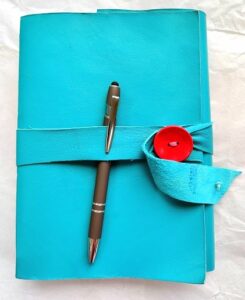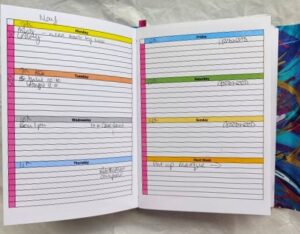Record keeping
A couple of years ago I wrote a series of blogs about using a bullet journal from both my perspective and yours. I have continued to use my journal every year, starting with the joy of making it myself, and it has been an absolute godsend for me.
With so many things for me to remember for exhibitions: Ginger Cactus Art; the continuing issues with my father’s legal affairs (two years after his death and still not settled!); teaching; website issues; arranging printing jobs etc. etc., having the journal means that whilst I know I have a ton of stuff to get through, I can prioritise what needs doing, and plan it out in the journal so that I have not been overwhelmed. Well, nearly.
There are always things that jump out at you and need dealing with, but I can look at my journal and see which days have less going on and make appointments or organise Zoom meetings around those times. It means that, overall, I feel in control. It also means that I have been able to manage other people’s expectations of me. Right down to “have I got time for that long phone call to a friend, or would I be best to drop a note for now and carve out some time a bit later when I know that my diary is looking clearer?” And whilst there have been a couple of weeks in the middle of the chaos in my life when I forgot to use it and found myself floundering around, getting back on track has been a life saver for me. So, I really hope you are all finding this tool useful in your lives.
This week, I want to look at keeping records in the context of taking part in an art exhibition. There are several different ways you can look at an exhibition and consider it a success. Clearly, whether (or not) you make any sales is the most obvious way, but it is not the be all and end all. Making connections with people interested in your work is hugely important. If you can get their contact details and add them to your email list all the better. Your email list needs growing constantly, and always remember that it is yours; it does not simply exist at the whim of Facebook, Instagram, Twitter etc. It should be treated with respect and improved on whenever possible.
Connecting with other artists is also very important. By cultivating relationships with others, you can find out about exhibitions you could take part in, connect with courses which may be of help and/or interest to you and make friends with people who really understand the difficulties we artists face trying to find a market for our work.
Last, but by no means least, information take-up is a great gauge of public interest in what you are producing. My leaflet take-up has been on the increase but you never know what, if anything, will come of this. I had one person come back to me two years later wanting me to make artwork for them, so it is a good gauge of interest and patience is a virtue.
So, those are some of the ways you can measure success, but it is worth doing a costing of the whole event so that you have an idea of just where you truly stand financially.
My advice would be to have a costing sheet of some kind. You could set this up in the back of your journal or you could use large index cards, but probably the easiest way unless you are not really tech savvy, is a spreadsheet on your computer.
What I do is create a spreadsheet titled with the name and date of the show. I have made a mock-up for a fake show – see below – so you can see if you like this approach.
For this to work properly, you must record all your costs: exhibition fees; travel expenses to and from the venue; printing your flyers/leaflets; and any other expenses pertinent to that show. You should already be keeping records and costings of producing and framing (where relevant) your artwork so that you can be sure you are not selling your work at a loss, so in this instance you do not need to include those kinds of figures, as we are just looking at one exhibition. Why? Because this way you’ll have a good idea whether the exhibition is worth attending next time around.
You could get really detailed here and work out the profit on the artwork you sold verses how much it cost you to take part so that you can see what your profit or loss was, but I know most of you are not selling huge numbers of works at these exhibitions, so let’s park that for the moment.
Add up what you have sold, take off all your expenses and you have the profitability of the show you have taken part in. This first spreadsheet shows income of £980.00 less expenses of £884.82, which gives you a small profit of £95.18.
The Greatest Art Exhibition
| June 2023 | Income | Expenses | ||
| paintings | 350.00 | Exhibition fees | 525 | |
| prints | 275.00 | Travel | 62 | |
| cards | 35.00 | Hotel expenses | 219 | |
| franchise | 155.00 | Meals | 67 | |
| other | 165.00 | printed info (47 taken) | 7.56 | |
| business cards (84 taken) | 4.26 | |||
| 980.00 | 884.82 | |||
But……………
If you want to dive deeper (and I know many of you don’t, but really you should), you will take the actual profit on the sales and compare that to your costs to see what the outcome is.
| The Greatest Art Exhibition | |||||
| June 2023 | Income | profit | Expenses | ||
| paintings | 350.00 | 50.00 | Exhibition fees | 525.00 | |
| prints | 275.00 | 75.00 | travel | 62.00 | |
| cards | 35.00 | 15.00 | hotel expenses | 219.00 | |
| franchise | 155.00 | 85.00 | meals | 67.00 | |
| other | 165.00 | 65.00 | printed info (47 taken) | 7.56 | |
| business cards (84 taken) | 4.26 | ||||
| 980.00 | 290.00 | 884.82 | -594.82 | ||
By looking at the full picture you can see that you have not made a profit at all, but you may be happy enough to have covered your exhibition costs so that you are more visible as an artist. The profit you made on your works sold of £290.00 less the expenses show a £594.82 loss.
Granted, this is an entirely made up and possibly extreme example, but if you want to understand your true financial position when taking part in the bigger exhibitions, I believe you need to keep all this information in mind.

It could also help you when deciding how to price your work as well as choosing which exhibitions to take part in. Information is power but only if you actually put it to good use.
A final thing to consider. Taking part in exhibitions can be expensive, particularly the big ones. If you are going to invest in these exhibitions you have to go with the mindset of marketing your art. I have attended a number of big shows and sold very little but by just being there I have met people who have come back to buy from me sometime later. I have also met people who want to come to the classes I teach and I have been presented with business opportunities which I wouldn’t have had if I had not taken a risk and attended the shows.
If you have enjoyed reading this post, please like and follow me and please share it with people who you think might be interested. I am always on the lookout for new artists to feature as I know how much everyone enjoys reading about artists. Also, if you think there is a subject you would like to know more about and would like me to write about, I will be happy to consider it. Sharing, liking and following my blogs increases the number of people the algorithm shows the blogs to, so please share. Thank you in advance for supporting me this way.
